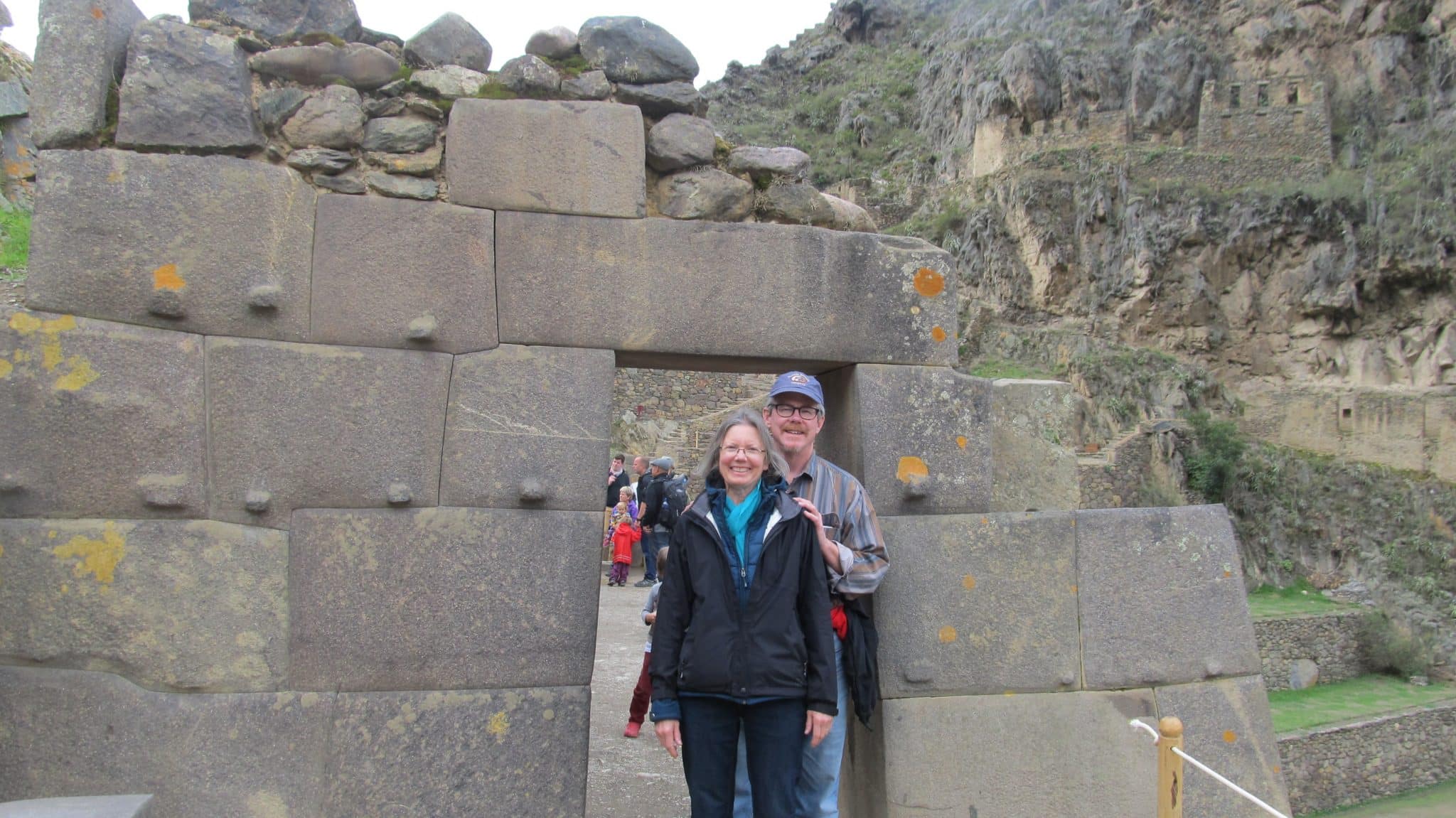Sacred Valley of Peru
We leave Lima and catch a plane to Cusco. We will acclimate for a few days in this city of a million people. It is two miles high and at this elevation it will help us with our endurance in the coming days. A long awaited trek, to Ollantaytambo is up the roadway in the Sacred Valley. It is approximately forty five kilometers as the condor flies. We travel in a bus and dodge small herds of sheep and pigs, donkeys and chickens as we watch teams of oxen plow the potato fields. The verdant mountain tops are sunlit with scattered clouds, clouds created by the proximity to the Amazon. We are entering a biome called the cloud forest. At this elevation the mountains in North America are treeless and we would be above the tree line. However with this high humidity we are instead in a cloud forest it is heavily vegetated and there are terraces in every direction and at every elevation.
The oxygen gets mighty thin at this elevation and it seems to decrease exponentially with each thousand feet of elevation.

Early mornings in the Sacred Valley are meant for hiking. Ollantaytambo is a magnificient religious plateau. Ollantaytambo has a vista so sweeping that it seems to have a view of the entire world. It is indeed a view of much of the Inkan world.
The precision stone work (dry stone masonry) that we find on this mountain top is stunning. It is found throughout Peru. Today very few stone masons could replicate this craftsmanship. It is made mostly of basaltic materials and is labor intensive. The amount of terraces and stonework in Peru suggests that this region was heavily populated with industrious, organized natives that understood the value of level growing surfaces.
I have marveled at stone work in Italy, Stone Henge in Great Britain, and many Cathedrals in Europe. South American stone craftsmanship ranks amongst the best in the world. It has lasted centuries perfectly intact. Their building techniques and engineering are unmatched. The walls have a very diagnostic feature, they are canted toward each other at approximately 13 degrees. This technique allows gravity to play a more critical role in stabilizing formations by leaning the wall slightly toward each other to provide mutually applied pressure. This advent in building techniques creates structures that tend to be seismographically more stable, ie; earthquake proof! This is something that U.S. society has started to consider in only the last century.

The Condor is considered the largest bird in the world with a wingspan exceeding ten feet. In my formative years reading about this bird sparked my interest in reading, nature and geography. A twenty second close up glimpse of this bird made my trip to South America complete. It is one of the animals revered by the Inkan culture. The condor carries prayers to heaven.
The following day we are approximately 200 miles from the Pacific coast line and hiking up the trails toward the fabled temple of Machuu Pichu. The fifteenth century temple was built for the Inkan royalty in an incredibly short period of time, suggesting tremendous amounts of skilled laborers. Below us is the Urubumba River, this river flows around the base of this mountain. Amazingly this river does not flow to the Pacific, it flows into the Atlantic Ocean approximately 2,700 distant. This river threads its way through the Andes into the amazonian basin and begins it journey eastward. Along the river bank (a thousand feet below) you can see a small pathway, it is the Inkan trail. If you happen to be the ruler of this Sacred Valley you have access to eastern and western watersheds. You can request fish from the Pacific Ocean and some rainforest delicacy from the Atlantic side of the mountains. You have cultural, economic and spiritual communication with greater populations other than your own.
Once again, consider the terracing, it is the obvious tourist fascination and each terrace is called a pata. One pata, two patas equal patapata and so on. On these patas potatoes are grown and some linguists/people surmise that perhaps this is where the word patato or potato begat. I suspect this is linguistic conjecture. On each pata the elevation creates a small variation of microclimate. Rain fall and temperature varied at each level and to stave off starvation you would want many small fields at many different levels. This understanding of farming one or two dozen different plots assures your continued existence because crop failures at any given level were common place.
The lack of flat and tillable land made for the creation of these labor intensive terraces. Each generation took on the task of going further up the mountain. Looking at the mountain side you can envision an entire family lineage, their life, their work, their sustenance.
Twelve to fourteen thousand years ago their ancestors crossed the Bering Sea Land bridge or else followed the Kelp Highway along the coast. In a blink of time they are creating new societies, religions, arts, crafts, economies and studying astronomy.
During the height of their short empire boats from Spain arrived. The Spanish had arrived at incredibly opportune time. A civil war had recently weakened the entire social fabric of South America and then came a European disease. Small pox traveled faster than any explorer. It decimated entire populations of native South Americans long before the news of the Spanish arrival. They had no resistance to European germs.
We have a place to sleep, we continue in the morning.
Bill Keitel
